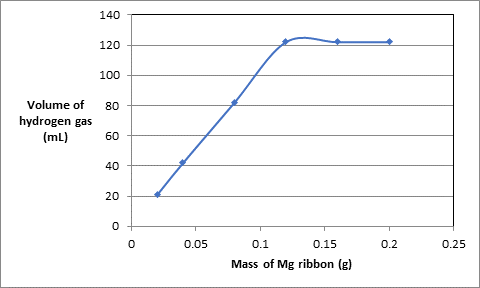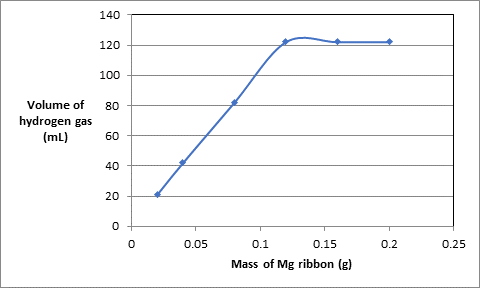
Concept explainers
Magnesium ribbon reacts with acid to produce hydro- gen gas and magnesium ions. Different masses of magnesium ribbon are added to 10 mL of the acid. The volume of the hydrogen gas obtained is a measure of the number of moles of hydrogen produced by the reaction. Various measurements are given in the table below.

(a) Draw a graph of the results by plotting the mass of Mg versus the volume of the hydrogen gas.
(b) What is the limiting reactant in experiment 1?
(c) What is the limiting reactant in experiment 3?
(d) What is the limiting reactant in experiment 6?
(e) Which experiment uses stoichiometric amounts of each reactant?
(f) What volume of gas would be obtained if 0.300 g of Mg ribbon were used? If 0.010 g were used?
(a)
Interpretation:.
The graph between mass of Mg versus the volume of hydrogen gas should be plotted..
Concept introduction:.
The number of moles of a substance is related to mass and molar mass as follows:.
Here,mis mass andMis molar mass of the substance..
The density of solution can be calculated as follow:.
Here, m is mass and V is volume.
Answer to Problem 74QAP

Explanation of Solution
The data of mass of Mg ribbon in grams and volume of hydrogen gas produced in experiments is as follows:.
| Experiment | Mass of Mg ribbon (g) | Volume of acid used (mL) | Volume of hydrogen gas (mL) |
| 1 | 0.020 | 10.0 | 21 |
| 2 | 0.040 | 10.0 | 42 |
| 3 | 0.080 | 10.0 | 82 |
| 4 | 0.120 | 10.0 | 122 |
| 5 | 0.160 | 10.0 | 122 |
| 6 | 0.200 | 10.0 | 122 |
To plot put the data of mass of Mg ribbon on x-axis and volume of hydrogen gas at y-axis:.

(b)
Interpretation:
The limiting reactant in experiment 1 should be determined..
Concept introduction:.
The number of moles of a substance is related to mass and molar mass as follows:.
Here,mis mass andMis molar mass of the substance..
The density of solution can be calculated as follow:.
Here, m is mass and V is volume.
Answer to Problem 74QAP
Mg is limiting reactant.
Explanation of Solution
The balanced chemical reaction will be as follows:.
According to experiment 1, mass of Mg ribbon is 0.020 g, volume of acid used is 10.0 mL and volume of
The density of
Putting the values,
Molar mass of
From the balanced chemical reaction, 1 mol of hydrogen gas is produced from 1 mol of Mg thus, number of moles of Mg required to produce
The mass of Mg is 0.020 g and molar mass of Mg is 24.305 g/mol thus, number of moles of Mg will be:.
Since, number of moles of Mg required is
(c)
Interpretation:
The limiting reactant in experiment 3 should be determined..
Concept introduction:.
The number of moles of a substance is related to mass and molar mass as follows:.
Here,mis mass andMis molar mass of the substance..
The density of solution can be calculated as follow:.
Here, m is mass and V is volume.
Answer to Problem 74QAP
Mg is limiting reactant.
Explanation of Solution
The balanced chemical reaction will be as follows:.
According to experiment 3, mass of Mg ribbon is 0.080 g, volume of acid used is 10.0 mL and volume of
The density of
Putting the values,
Molar mass of
From the balanced chemical reaction, 1 mol of hydrogen gas is produced from 1 mol of Mg thus, number of moles of Mg required to produce
The mass of Mg is 0.080 g and molar mass of Mg is 24.305 g/mol thus, number of moles of Mg will be:.
Since, number of moles of Mg required is
(d)
Interpretation:
The limiting reactant in experiment 6 should be determined..
Concept introduction:.
The number of moles of a substance is related to mass and molar mass as follows:.
Here,mis mass andMis molar mass of the substance..
The density of solution can be calculated as follow:.
Here, m is mass and V is volume.
Answer to Problem 74QAP
Acid is limiting reactant.
Explanation of Solution
The balanced chemical reaction will be as follows:.
According to experiment 6, mass of Mg ribbon is 0.200 g, volume of acid used is 10.0 mL and volume of
The density of
Putting the values,
Molar mass of
From the balanced chemical reaction, 1 mol of hydrogen gas is produced from 1 mol of Mg thus, number of moles of Mg required to produce
The mass of Mg is 0.200 g and molar mass of Mg is 24.305 g/mol thus, number of moles of Mg will be:.
Since, number of moles of Mg required is
(e)
Interpretation:
The experiment that uses stoichiometric amounts of each reactant should be determined..
Concept introduction:.
The number of moles of a substance is related to mass and molar mass as follows:.
Here,mis mass andMis molar mass of the substance..
The density of solution can be calculated as follow:.
Here, m is mass and V is volume.
Answer to Problem 74QAP
Experiment 4.
Explanation of Solution
According to balance chemical reaction, 1 mol of Mg gives 1 mol of hydrogen gas thus, the experiment in which same number of moles of Mg reacts with acid to form hydrogen gas that experiment uses stoichiometric amounts of each reactant..
This cannot be experiment 1, 3 and 6 because ratio of number of moles of Mg and hydrogen gas is not 1:1 in these experiments..
Check experiment 2: mass of Mg is 0.040 g and molar mass of Mg is 24.305 g/mol thus, number of mol of Mg will be:
The volume of
The density of
Putting the values,
Molar mass of
The number of moles of Mg and hydrogen gas is not same thus, it is not experiment 2..
Check experiment 4: mass of Mg is 0.120 g and molar mass of Mg is 24.305 g/mol thus, number of mol of Mg will be:
The volume of
The density of
Putting the values,
Molar mass of
The number of moles of Mg and hydrogen gas is approximately same thus, it is experiment 4..
Check experiment 5: mass of Mg is 0.160 g and molar mass of Mg is 24.305 g/mol thus, number of mol of Mg will be:
The volume of
The density of
Putting the values,
Molar mass of
The number of moles of Mg and hydrogen gas is not same thus, it is not experiment 4..
Therefore, experiment 4 uses stoichiometric amounts of each reactant.
(f)
Interpretation:
The volume of the gas for 0.300 g and 0.010 g of Mg ribbon should be calculated.
Concept introduction:.
The number of moles of a substance is related to mass and molar mass as follows:.
Here,mis mass andMis molar mass of the substance..
The density of solution can be calculated as follow:.
Here, m is mass and V is volume.
Answer to Problem 74QAP
The volume of hydrogen gas produced from 0.120 g of Mg and 0.010 g of Mg is 122 mL and 11.32 mL respectively.
Explanation of Solution
The graph between mass of Mg ribbon and volume of hydrogen gas is as follows:.

According to the graph, above the mass of Mg 0.120 g, the volume of hydrogen gas becomes constant at 122 mL thus, the volume of hydrogen gas produced if 0.120 g of Mg is burned will be 122 mL.
Considering only the straight line in the graph,.
| Experiment | Mass of Mg ribbon (g) | Volume of acid used (mL) | Volume of hydrogen gas (mL) |
| 1 | 0.020 | 10.0 | 21 |
| 2 | 0.040 | 10.0 | 42 |
| 3 | 0.080 | 10.0 | 82 |
| 4 | 0.120 | 10.0 | 122 |
The plot will be as follows:.

Comparing this with equation of straight line
For the mass of ribbon 0.010 g, the volume of hydrogen gas can be calculated as follows:.
Therefore, the volume of hydrogen gas is 11.32 mL.
Want to see more full solutions like this?
Chapter 3 Solutions
CHEMISTRY:PRIN.+REACTIONS-OWLV2 ACCESS
- 6. Choose the compound that will produce the spectrum below and assign the signals as carbonyl, aryl, or alkyl. 100 ō (ppm) 50 0 7. 200 150 Assign all of the protons on the spectrum below. 8. A B 4 E C 3 ō (ppm) 2 1 0 Choose the compound that will produce the spectrum below and assign the signals to the corresponding protons. OH 6 OH 3 2 1 0 4 ō (ppm)arrow_forwardIn the Thermo Fisher application note about wine analysis (Lesson 3), the following chromatogram was collected of nine components of wine. If peak 3 has a retention time of 3.15 minutes and a peak width of 0.070 minutes, and peak 4 has a retention time of 3.24 minutes and a peak width of 0.075 minutes, what is the resolution factor between the two peaks? [Hint: it will help to review Lesson 2 for this question.] MAU 300 200 T 34 5 100- 1 2 CO 6 7 8 9 0 2.4 2.6 2.8 3.0 3.2 3.4 3.6 3.8 4.0 4.2 4.4 4.6 4.8 5.0 5.2 Minutes 3.22 0.62 1.04 O 1.24arrow_forwardThe diagram shows two metals, A and B, which melt at 1000°C and 1400°C. State the weight percentage of the primary constituent (grains of C) that would be obtained by solidifying a 20% alloy of B. 1000°C a+L L+C 900°С 12 α a+C 45 1200 C L+y 140096 C+Y a+ß 800°C 700°C C+B 96 92 a+B 0 10 20 30 40 50 60 70 80 90 100 A % peso B Barrow_forward
- 8. Choose the compound that will produce the spectrum below and assign the signals to the corresponding protons. 2 4 3 ō (ppm) OH 4 6 6 СОН 2 1 0arrow_forward7. Assign all of the protons on the spectrum below. A B 2 C E 2 1 3 6 4 3 2 1 0arrow_forwarde. If (3R,4R)-3,4-dichloro-2,5-dimethylhexane and (3R,4S)-3,4-dichloro-2,5-dimethylhexane are in a solution at the same concentration, would this solution be expected to rotate plane polarized light (that is, be optically active)? Please provide your reasoning for your answer. [If you read this problem carefully, you will not need to draw out the structures to arrive at your answer...]arrow_forward
- 1. How many neighbors does the proton that produces the multiplet below have? 2. 3. اللـ Draw a partial structure from the multiplet below. (The integration of the multiplet is 6) M Using the additivity constants found in appendix G of your lab manual, calculate the approximate chemical shifts of the protons indicated below. (Show your work!!!) B A Br SHarrow_forward1) Suppose 0.1 kg ice at 0°C (273K) is in 0.5kg water at 20°C (293K). What is the change in entropy of the ice as it melts at 0°? To produce the original "water gas" mixture, carbon (in a combustible form known as coke) is reacted with steam: 131.4 kJ + H20(g) + C(s) → CO(g) + H2(g) From this information and the equations in the previous problem, calculate the enthalpy for the combustion or carbon to form carbon dioxide. kindly show me how to solve this long problem. Thanksarrow_forward4. An 'H-NMR of a compound is acquired. The integration for signal A is 5692 and the integration for signal B is 25614. What is the simplest whole number ratio of protons for signals A and B? (Show your work!!!) 5. Assign the carbons in the NMR below as either carbonyl, aromatic, or alkyl. 200 150 100 50 ō (ppm) 1arrow_forward
- Speaking of composite materials, indicate the correct option:(A). Composite materials can only be: metal-polymer or polymer-polymer.(B). Composite materials can be made up of particles, but not fibers or sheets.(C). When the reinforcing particles are uniformly distributed in a composite material, there may be a greater tendency for it to have isotropic properties.(D). None of the above is correct.arrow_forwardIf we are talking about viscoelastic modulus or viscoelastic relaxation modulus in polymers, indicate the correct option.(A). It reports the variation of elastic behavior as a function of time.(B). It is only useful for defining its glass transition temperature.(C). It only allows us to define the polymer degradation temperature.(D). Neither option is correct.arrow_forwardWhen natural light falls perpendicularly on a material A, it has a reflectivity of 0.813%. Indicate the value of the refractive index.arrow_forward
 Chemistry for Engineering StudentsChemistryISBN:9781337398909Author:Lawrence S. Brown, Tom HolmePublisher:Cengage Learning
Chemistry for Engineering StudentsChemistryISBN:9781337398909Author:Lawrence S. Brown, Tom HolmePublisher:Cengage Learning Chemistry & Chemical ReactivityChemistryISBN:9781337399074Author:John C. Kotz, Paul M. Treichel, John Townsend, David TreichelPublisher:Cengage Learning
Chemistry & Chemical ReactivityChemistryISBN:9781337399074Author:John C. Kotz, Paul M. Treichel, John Townsend, David TreichelPublisher:Cengage Learning ChemistryChemistryISBN:9781305957404Author:Steven S. Zumdahl, Susan A. Zumdahl, Donald J. DeCostePublisher:Cengage Learning
ChemistryChemistryISBN:9781305957404Author:Steven S. Zumdahl, Susan A. Zumdahl, Donald J. DeCostePublisher:Cengage Learning Chemistry: An Atoms First ApproachChemistryISBN:9781305079243Author:Steven S. Zumdahl, Susan A. ZumdahlPublisher:Cengage Learning
Chemistry: An Atoms First ApproachChemistryISBN:9781305079243Author:Steven S. Zumdahl, Susan A. ZumdahlPublisher:Cengage Learning
 World of Chemistry, 3rd editionChemistryISBN:9781133109655Author:Steven S. Zumdahl, Susan L. Zumdahl, Donald J. DeCostePublisher:Brooks / Cole / Cengage Learning
World of Chemistry, 3rd editionChemistryISBN:9781133109655Author:Steven S. Zumdahl, Susan L. Zumdahl, Donald J. DeCostePublisher:Brooks / Cole / Cengage Learning





